University Assignment: Reflection on Patient Care with Chronic Illness
VerifiedAdded on 2023/06/03
|6
|1616
|223
Essay
AI Summary
This essay is a reflection on patient care for chronic illness, using the Gibb's reflective model. The essay details a case study of a 72-year-old male patient admitted to a surgical ward with severe COPD, chronic bronchitis, and related complications. The student nurse describes the patient's condition, including symptoms like aggravated coughing, shortness of breath, and difficulties with self-care, and discusses the importance of hygiene and nutritional support. The reflection covers feelings, evaluations, and analyses of the situation, including the use of the Malnutrition Universal Screening Tool (MUST) and the need for modified food textures. The essay further explores psychosocial factors affecting patient care and proposes an action plan involving a multi-disciplinary team and rehabilitation services to improve patient outcomes. The conclusion emphasizes the crucial role of nurses in providing compassionate care for patients with chronic illnesses like COPD, and the benefits of reflective practice in enhancing critical thinking and caregiving skills. The essay also contains references to support the findings.

Running head: REFLECTION ON PATIENT CARE WITH CHRONIC ILLNESS
Reflection on patient care with chronic illness
Name of the Student
Name of the University
Author Note:
Reflection on patient care with chronic illness
Name of the Student
Name of the University
Author Note:
Paraphrase This Document
Need a fresh take? Get an instant paraphrase of this document with our AI Paraphraser
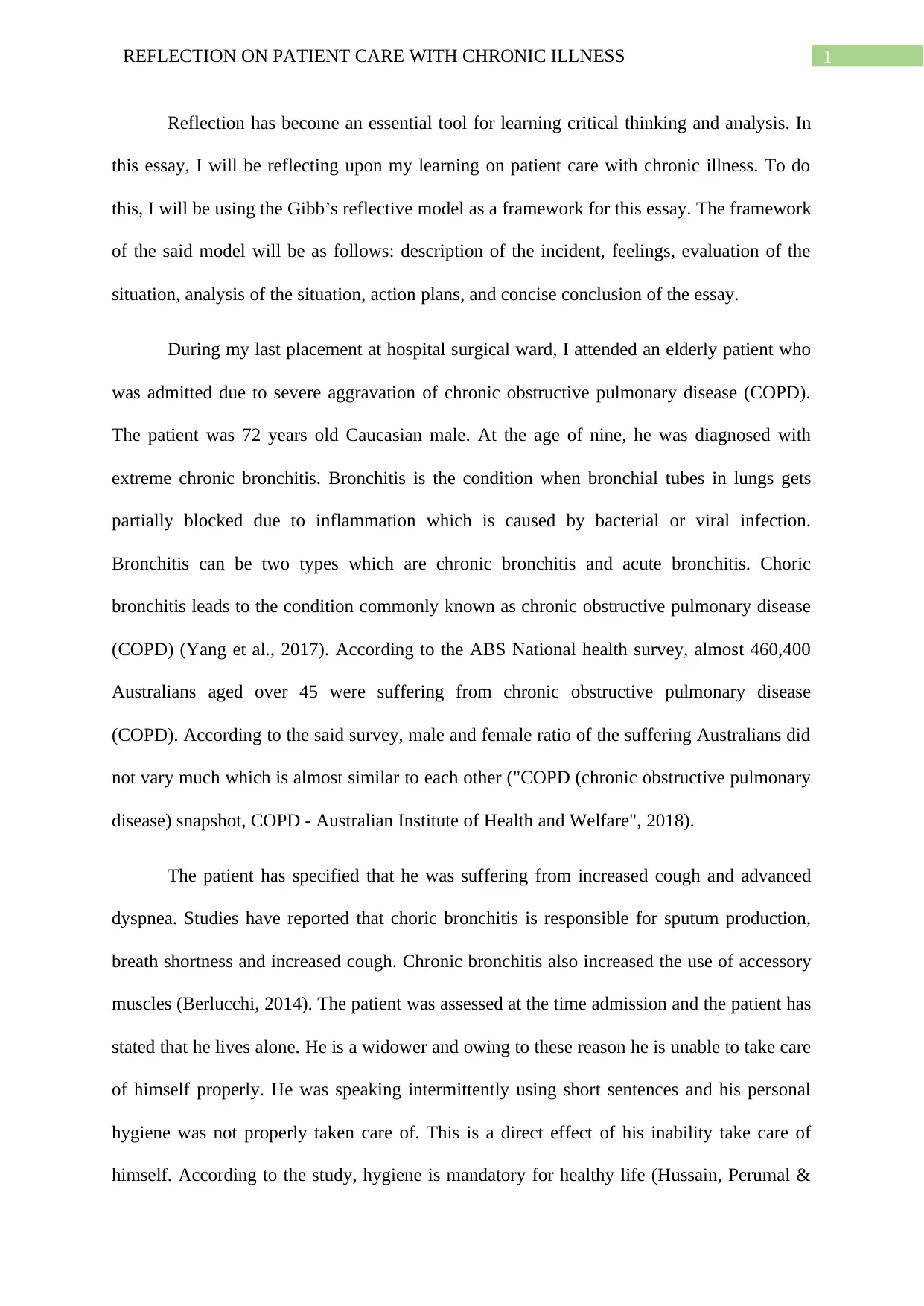
1REFLECTION ON PATIENT CARE WITH CHRONIC ILLNESS
Reflection has become an essential tool for learning critical thinking and analysis. In
this essay, I will be reflecting upon my learning on patient care with chronic illness. To do
this, I will be using the Gibb’s reflective model as a framework for this essay. The framework
of the said model will be as follows: description of the incident, feelings, evaluation of the
situation, analysis of the situation, action plans, and concise conclusion of the essay.
During my last placement at hospital surgical ward, I attended an elderly patient who
was admitted due to severe aggravation of chronic obstructive pulmonary disease (COPD).
The patient was 72 years old Caucasian male. At the age of nine, he was diagnosed with
extreme chronic bronchitis. Bronchitis is the condition when bronchial tubes in lungs gets
partially blocked due to inflammation which is caused by bacterial or viral infection.
Bronchitis can be two types which are chronic bronchitis and acute bronchitis. Choric
bronchitis leads to the condition commonly known as chronic obstructive pulmonary disease
(COPD) (Yang et al., 2017). According to the ABS National health survey, almost 460,400
Australians aged over 45 were suffering from chronic obstructive pulmonary disease
(COPD). According to the said survey, male and female ratio of the suffering Australians did
not vary much which is almost similar to each other ("COPD (chronic obstructive pulmonary
disease) snapshot, COPD - Australian Institute of Health and Welfare", 2018).
The patient has specified that he was suffering from increased cough and advanced
dyspnea. Studies have reported that choric bronchitis is responsible for sputum production,
breath shortness and increased cough. Chronic bronchitis also increased the use of accessory
muscles (Berlucchi, 2014). The patient was assessed at the time admission and the patient has
stated that he lives alone. He is a widower and owing to these reason he is unable to take care
of himself properly. He was speaking intermittently using short sentences and his personal
hygiene was not properly taken care of. This is a direct effect of his inability take care of
himself. According to the study, hygiene is mandatory for healthy life (Hussain, Perumal &
Reflection has become an essential tool for learning critical thinking and analysis. In
this essay, I will be reflecting upon my learning on patient care with chronic illness. To do
this, I will be using the Gibb’s reflective model as a framework for this essay. The framework
of the said model will be as follows: description of the incident, feelings, evaluation of the
situation, analysis of the situation, action plans, and concise conclusion of the essay.
During my last placement at hospital surgical ward, I attended an elderly patient who
was admitted due to severe aggravation of chronic obstructive pulmonary disease (COPD).
The patient was 72 years old Caucasian male. At the age of nine, he was diagnosed with
extreme chronic bronchitis. Bronchitis is the condition when bronchial tubes in lungs gets
partially blocked due to inflammation which is caused by bacterial or viral infection.
Bronchitis can be two types which are chronic bronchitis and acute bronchitis. Choric
bronchitis leads to the condition commonly known as chronic obstructive pulmonary disease
(COPD) (Yang et al., 2017). According to the ABS National health survey, almost 460,400
Australians aged over 45 were suffering from chronic obstructive pulmonary disease
(COPD). According to the said survey, male and female ratio of the suffering Australians did
not vary much which is almost similar to each other ("COPD (chronic obstructive pulmonary
disease) snapshot, COPD - Australian Institute of Health and Welfare", 2018).
The patient has specified that he was suffering from increased cough and advanced
dyspnea. Studies have reported that choric bronchitis is responsible for sputum production,
breath shortness and increased cough. Chronic bronchitis also increased the use of accessory
muscles (Berlucchi, 2014). The patient was assessed at the time admission and the patient has
stated that he lives alone. He is a widower and owing to these reason he is unable to take care
of himself properly. He was speaking intermittently using short sentences and his personal
hygiene was not properly taken care of. This is a direct effect of his inability take care of
himself. According to the study, hygiene is mandatory for healthy life (Hussain, Perumal &
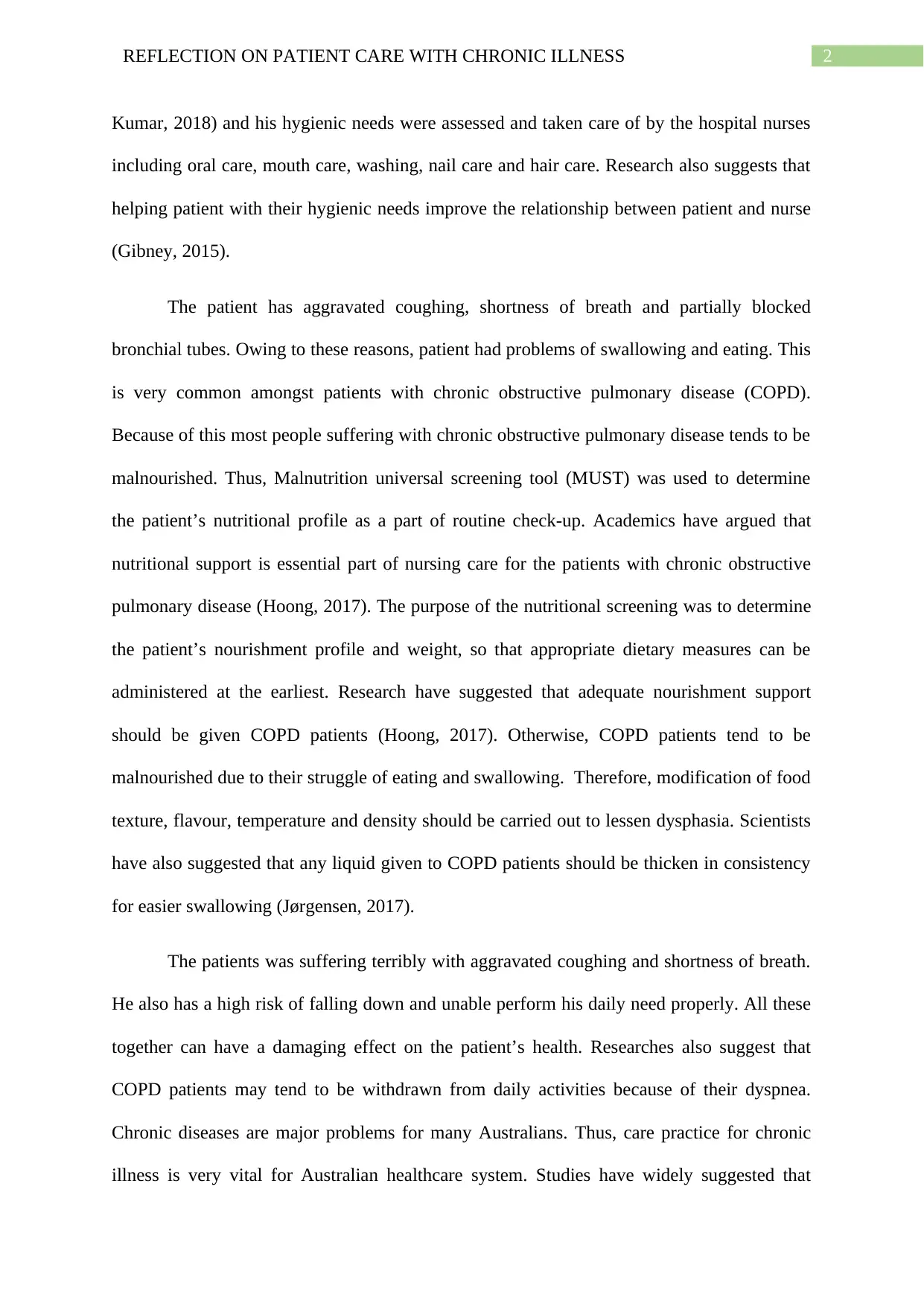
2REFLECTION ON PATIENT CARE WITH CHRONIC ILLNESS
Kumar, 2018) and his hygienic needs were assessed and taken care of by the hospital nurses
including oral care, mouth care, washing, nail care and hair care. Research also suggests that
helping patient with their hygienic needs improve the relationship between patient and nurse
(Gibney, 2015).
The patient has aggravated coughing, shortness of breath and partially blocked
bronchial tubes. Owing to these reasons, patient had problems of swallowing and eating. This
is very common amongst patients with chronic obstructive pulmonary disease (COPD).
Because of this most people suffering with chronic obstructive pulmonary disease tends to be
malnourished. Thus, Malnutrition universal screening tool (MUST) was used to determine
the patient’s nutritional profile as a part of routine check-up. Academics have argued that
nutritional support is essential part of nursing care for the patients with chronic obstructive
pulmonary disease (Hoong, 2017). The purpose of the nutritional screening was to determine
the patient’s nourishment profile and weight, so that appropriate dietary measures can be
administered at the earliest. Research have suggested that adequate nourishment support
should be given COPD patients (Hoong, 2017). Otherwise, COPD patients tend to be
malnourished due to their struggle of eating and swallowing. Therefore, modification of food
texture, flavour, temperature and density should be carried out to lessen dysphasia. Scientists
have also suggested that any liquid given to COPD patients should be thicken in consistency
for easier swallowing (Jørgensen, 2017).
The patients was suffering terribly with aggravated coughing and shortness of breath.
He also has a high risk of falling down and unable perform his daily need properly. All these
together can have a damaging effect on the patient’s health. Researches also suggest that
COPD patients may tend to be withdrawn from daily activities because of their dyspnea.
Chronic diseases are major problems for many Australians. Thus, care practice for chronic
illness is very vital for Australian healthcare system. Studies have widely suggested that
Kumar, 2018) and his hygienic needs were assessed and taken care of by the hospital nurses
including oral care, mouth care, washing, nail care and hair care. Research also suggests that
helping patient with their hygienic needs improve the relationship between patient and nurse
(Gibney, 2015).
The patient has aggravated coughing, shortness of breath and partially blocked
bronchial tubes. Owing to these reasons, patient had problems of swallowing and eating. This
is very common amongst patients with chronic obstructive pulmonary disease (COPD).
Because of this most people suffering with chronic obstructive pulmonary disease tends to be
malnourished. Thus, Malnutrition universal screening tool (MUST) was used to determine
the patient’s nutritional profile as a part of routine check-up. Academics have argued that
nutritional support is essential part of nursing care for the patients with chronic obstructive
pulmonary disease (Hoong, 2017). The purpose of the nutritional screening was to determine
the patient’s nourishment profile and weight, so that appropriate dietary measures can be
administered at the earliest. Research have suggested that adequate nourishment support
should be given COPD patients (Hoong, 2017). Otherwise, COPD patients tend to be
malnourished due to their struggle of eating and swallowing. Therefore, modification of food
texture, flavour, temperature and density should be carried out to lessen dysphasia. Scientists
have also suggested that any liquid given to COPD patients should be thicken in consistency
for easier swallowing (Jørgensen, 2017).
The patients was suffering terribly with aggravated coughing and shortness of breath.
He also has a high risk of falling down and unable perform his daily need properly. All these
together can have a damaging effect on the patient’s health. Researches also suggest that
COPD patients may tend to be withdrawn from daily activities because of their dyspnea.
Chronic diseases are major problems for many Australians. Thus, care practice for chronic
illness is very vital for Australian healthcare system. Studies have widely suggested that
⊘ This is a preview!⊘
Do you want full access?
Subscribe today to unlock all pages.

Trusted by 1+ million students worldwide
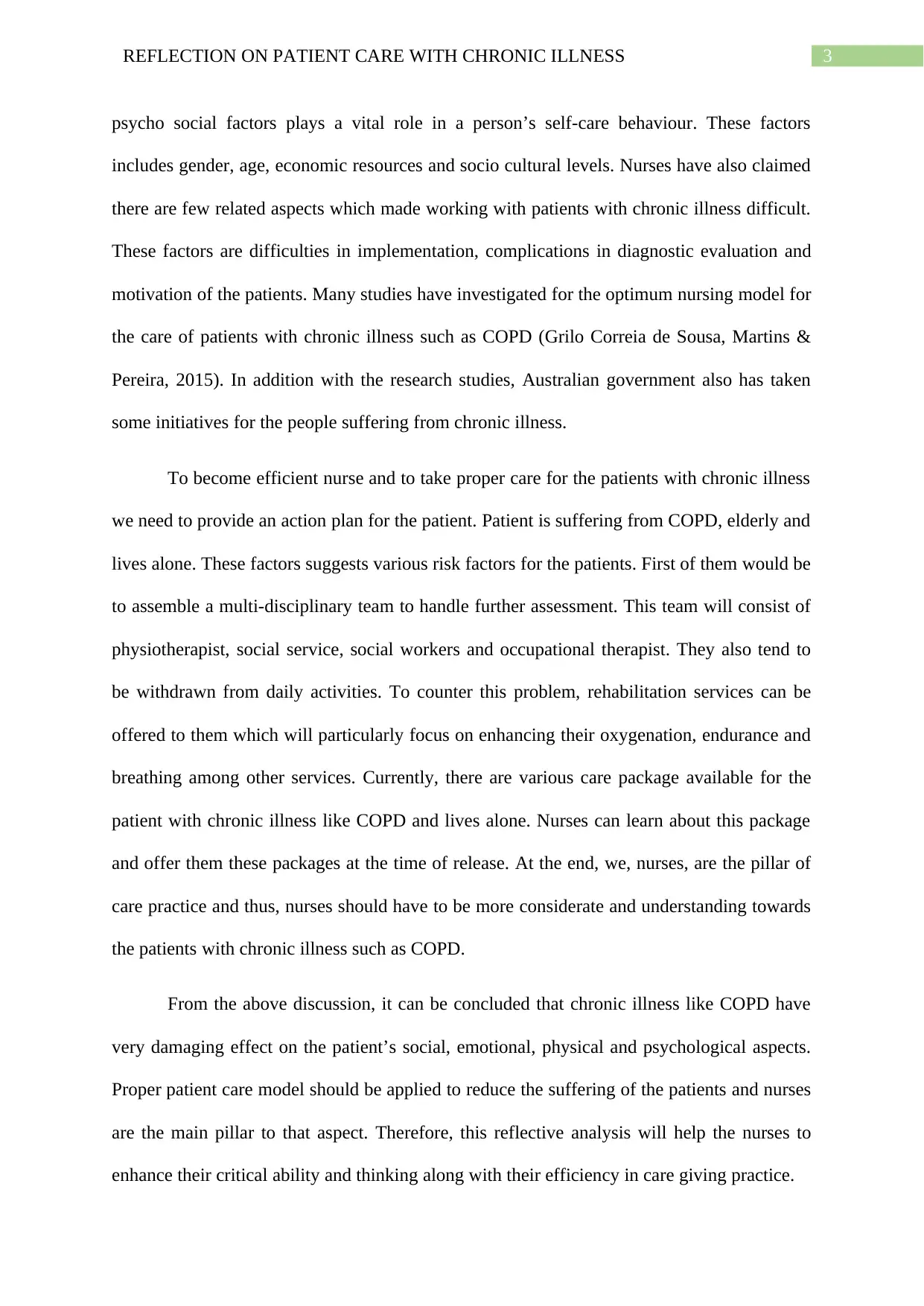
3REFLECTION ON PATIENT CARE WITH CHRONIC ILLNESS
psycho social factors plays a vital role in a person’s self-care behaviour. These factors
includes gender, age, economic resources and socio cultural levels. Nurses have also claimed
there are few related aspects which made working with patients with chronic illness difficult.
These factors are difficulties in implementation, complications in diagnostic evaluation and
motivation of the patients. Many studies have investigated for the optimum nursing model for
the care of patients with chronic illness such as COPD (Grilo Correia de Sousa, Martins &
Pereira, 2015). In addition with the research studies, Australian government also has taken
some initiatives for the people suffering from chronic illness.
To become efficient nurse and to take proper care for the patients with chronic illness
we need to provide an action plan for the patient. Patient is suffering from COPD, elderly and
lives alone. These factors suggests various risk factors for the patients. First of them would be
to assemble a multi-disciplinary team to handle further assessment. This team will consist of
physiotherapist, social service, social workers and occupational therapist. They also tend to
be withdrawn from daily activities. To counter this problem, rehabilitation services can be
offered to them which will particularly focus on enhancing their oxygenation, endurance and
breathing among other services. Currently, there are various care package available for the
patient with chronic illness like COPD and lives alone. Nurses can learn about this package
and offer them these packages at the time of release. At the end, we, nurses, are the pillar of
care practice and thus, nurses should have to be more considerate and understanding towards
the patients with chronic illness such as COPD.
From the above discussion, it can be concluded that chronic illness like COPD have
very damaging effect on the patient’s social, emotional, physical and psychological aspects.
Proper patient care model should be applied to reduce the suffering of the patients and nurses
are the main pillar to that aspect. Therefore, this reflective analysis will help the nurses to
enhance their critical ability and thinking along with their efficiency in care giving practice.
psycho social factors plays a vital role in a person’s self-care behaviour. These factors
includes gender, age, economic resources and socio cultural levels. Nurses have also claimed
there are few related aspects which made working with patients with chronic illness difficult.
These factors are difficulties in implementation, complications in diagnostic evaluation and
motivation of the patients. Many studies have investigated for the optimum nursing model for
the care of patients with chronic illness such as COPD (Grilo Correia de Sousa, Martins &
Pereira, 2015). In addition with the research studies, Australian government also has taken
some initiatives for the people suffering from chronic illness.
To become efficient nurse and to take proper care for the patients with chronic illness
we need to provide an action plan for the patient. Patient is suffering from COPD, elderly and
lives alone. These factors suggests various risk factors for the patients. First of them would be
to assemble a multi-disciplinary team to handle further assessment. This team will consist of
physiotherapist, social service, social workers and occupational therapist. They also tend to
be withdrawn from daily activities. To counter this problem, rehabilitation services can be
offered to them which will particularly focus on enhancing their oxygenation, endurance and
breathing among other services. Currently, there are various care package available for the
patient with chronic illness like COPD and lives alone. Nurses can learn about this package
and offer them these packages at the time of release. At the end, we, nurses, are the pillar of
care practice and thus, nurses should have to be more considerate and understanding towards
the patients with chronic illness such as COPD.
From the above discussion, it can be concluded that chronic illness like COPD have
very damaging effect on the patient’s social, emotional, physical and psychological aspects.
Proper patient care model should be applied to reduce the suffering of the patients and nurses
are the main pillar to that aspect. Therefore, this reflective analysis will help the nurses to
enhance their critical ability and thinking along with their efficiency in care giving practice.
Paraphrase This Document
Need a fresh take? Get an instant paraphrase of this document with our AI Paraphraser
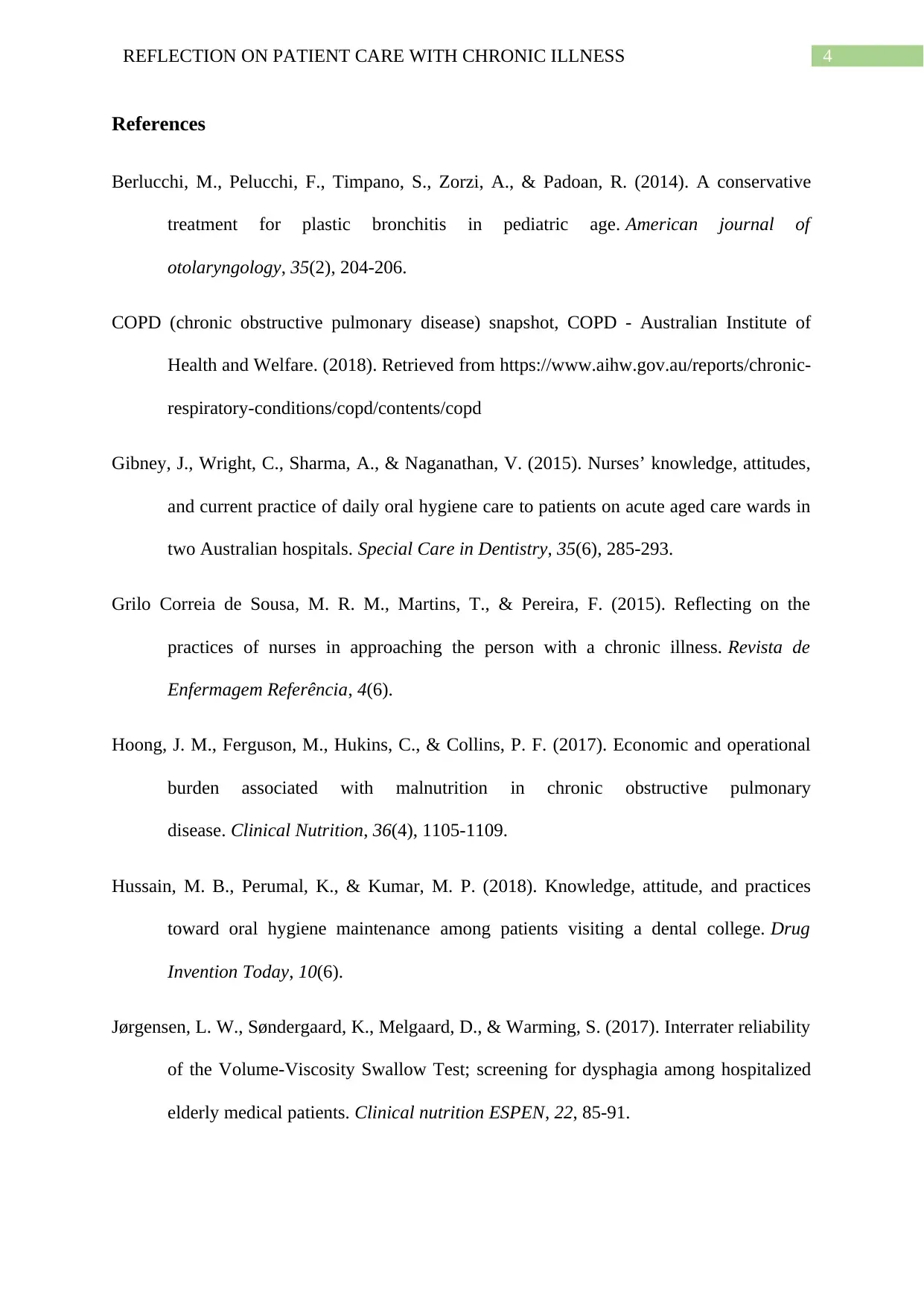
4REFLECTION ON PATIENT CARE WITH CHRONIC ILLNESS
References
Berlucchi, M., Pelucchi, F., Timpano, S., Zorzi, A., & Padoan, R. (2014). A conservative
treatment for plastic bronchitis in pediatric age. American journal of
otolaryngology, 35(2), 204-206.
COPD (chronic obstructive pulmonary disease) snapshot, COPD - Australian Institute of
Health and Welfare. (2018). Retrieved from https://www.aihw.gov.au/reports/chronic-
respiratory-conditions/copd/contents/copd
Gibney, J., Wright, C., Sharma, A., & Naganathan, V. (2015). Nurses’ knowledge, attitudes,
and current practice of daily oral hygiene care to patients on acute aged care wards in
two Australian hospitals. Special Care in Dentistry, 35(6), 285-293.
Grilo Correia de Sousa, M. R. M., Martins, T., & Pereira, F. (2015). Reflecting on the
practices of nurses in approaching the person with a chronic illness. Revista de
Enfermagem Referência, 4(6).
Hoong, J. M., Ferguson, M., Hukins, C., & Collins, P. F. (2017). Economic and operational
burden associated with malnutrition in chronic obstructive pulmonary
disease. Clinical Nutrition, 36(4), 1105-1109.
Hussain, M. B., Perumal, K., & Kumar, M. P. (2018). Knowledge, attitude, and practices
toward oral hygiene maintenance among patients visiting a dental college. Drug
Invention Today, 10(6).
Jørgensen, L. W., Søndergaard, K., Melgaard, D., & Warming, S. (2017). Interrater reliability
of the Volume-Viscosity Swallow Test; screening for dysphagia among hospitalized
elderly medical patients. Clinical nutrition ESPEN, 22, 85-91.
References
Berlucchi, M., Pelucchi, F., Timpano, S., Zorzi, A., & Padoan, R. (2014). A conservative
treatment for plastic bronchitis in pediatric age. American journal of
otolaryngology, 35(2), 204-206.
COPD (chronic obstructive pulmonary disease) snapshot, COPD - Australian Institute of
Health and Welfare. (2018). Retrieved from https://www.aihw.gov.au/reports/chronic-
respiratory-conditions/copd/contents/copd
Gibney, J., Wright, C., Sharma, A., & Naganathan, V. (2015). Nurses’ knowledge, attitudes,
and current practice of daily oral hygiene care to patients on acute aged care wards in
two Australian hospitals. Special Care in Dentistry, 35(6), 285-293.
Grilo Correia de Sousa, M. R. M., Martins, T., & Pereira, F. (2015). Reflecting on the
practices of nurses in approaching the person with a chronic illness. Revista de
Enfermagem Referência, 4(6).
Hoong, J. M., Ferguson, M., Hukins, C., & Collins, P. F. (2017). Economic and operational
burden associated with malnutrition in chronic obstructive pulmonary
disease. Clinical Nutrition, 36(4), 1105-1109.
Hussain, M. B., Perumal, K., & Kumar, M. P. (2018). Knowledge, attitude, and practices
toward oral hygiene maintenance among patients visiting a dental college. Drug
Invention Today, 10(6).
Jørgensen, L. W., Søndergaard, K., Melgaard, D., & Warming, S. (2017). Interrater reliability
of the Volume-Viscosity Swallow Test; screening for dysphagia among hospitalized
elderly medical patients. Clinical nutrition ESPEN, 22, 85-91.
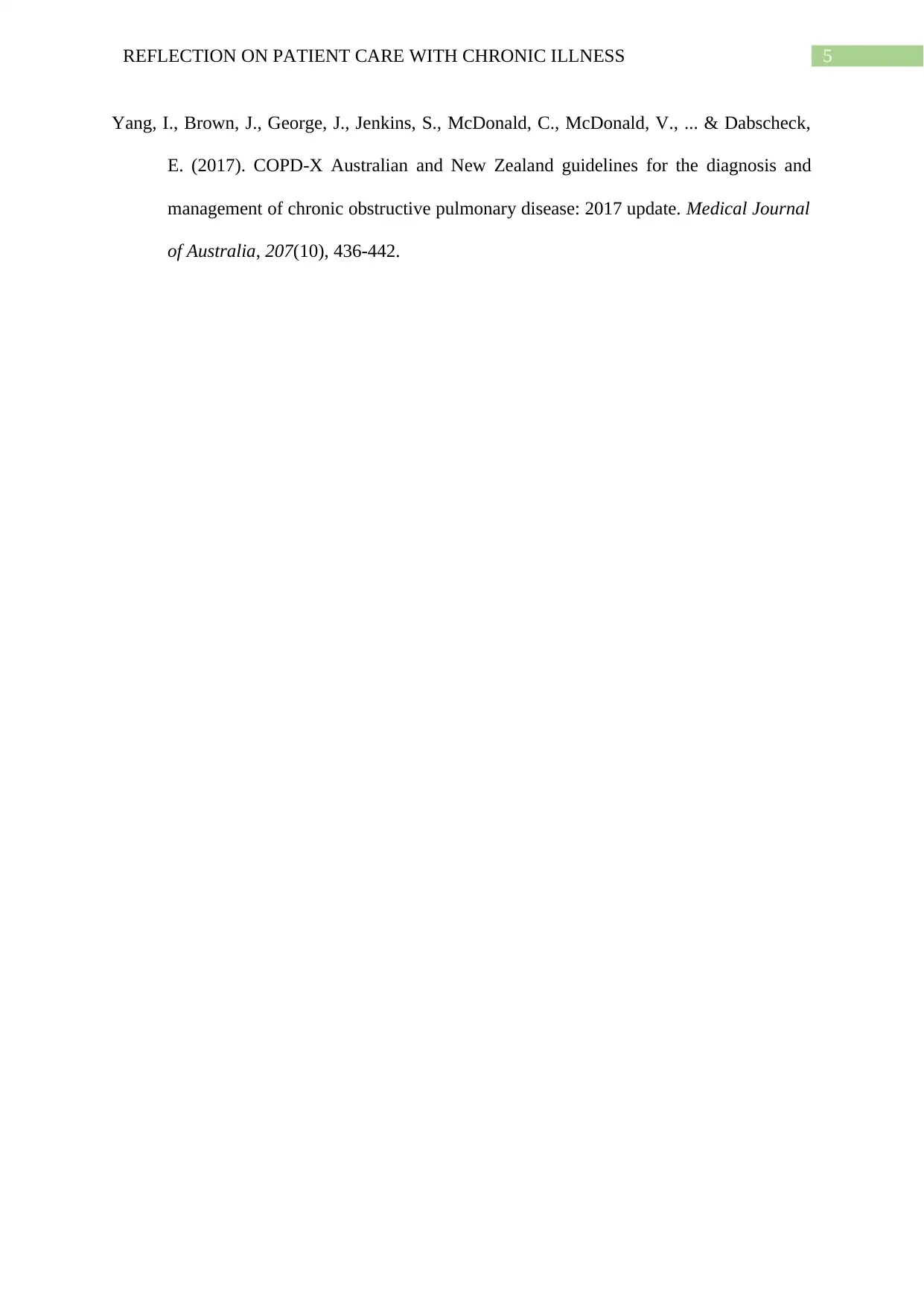
5REFLECTION ON PATIENT CARE WITH CHRONIC ILLNESS
Yang, I., Brown, J., George, J., Jenkins, S., McDonald, C., McDonald, V., ... & Dabscheck,
E. (2017). COPD-X Australian and New Zealand guidelines for the diagnosis and
management of chronic obstructive pulmonary disease: 2017 update. Medical Journal
of Australia, 207(10), 436-442.
Yang, I., Brown, J., George, J., Jenkins, S., McDonald, C., McDonald, V., ... & Dabscheck,
E. (2017). COPD-X Australian and New Zealand guidelines for the diagnosis and
management of chronic obstructive pulmonary disease: 2017 update. Medical Journal
of Australia, 207(10), 436-442.
⊘ This is a preview!⊘
Do you want full access?
Subscribe today to unlock all pages.

Trusted by 1+ million students worldwide
1 out of 6
Related Documents
Your All-in-One AI-Powered Toolkit for Academic Success.
+13062052269
info@desklib.com
Available 24*7 on WhatsApp / Email
![[object Object]](/_next/static/media/star-bottom.7253800d.svg)
Unlock your academic potential
Copyright © 2020–2025 A2Z Services. All Rights Reserved. Developed and managed by ZUCOL.




